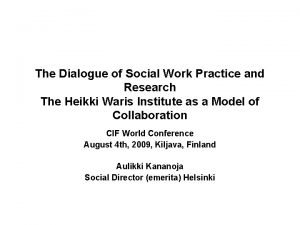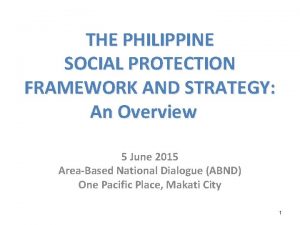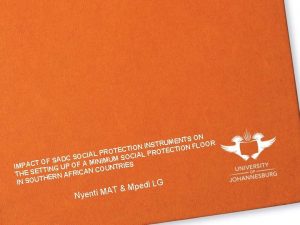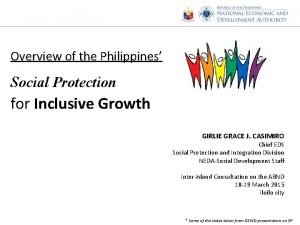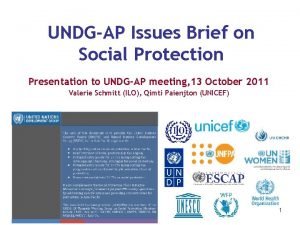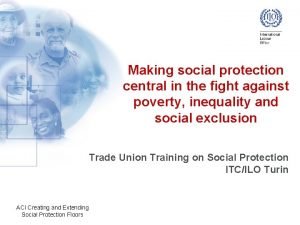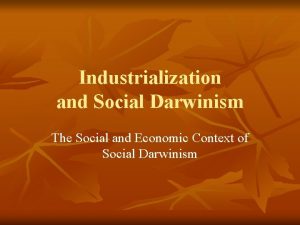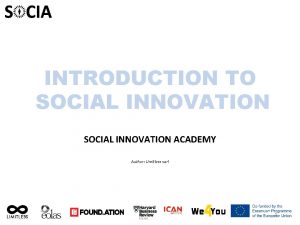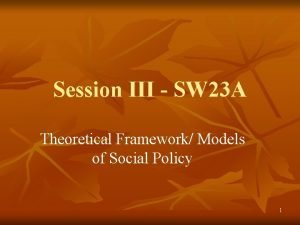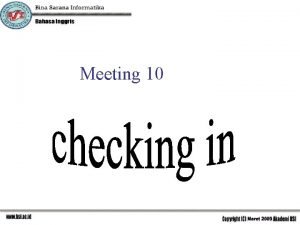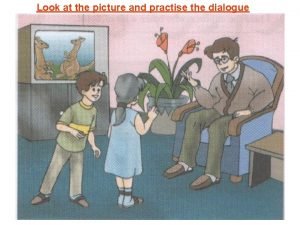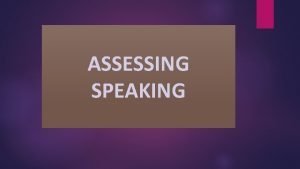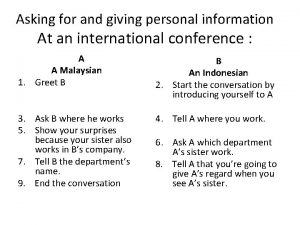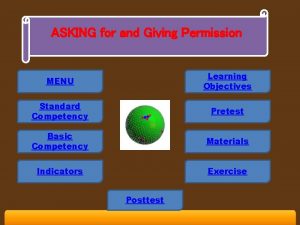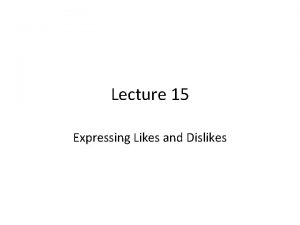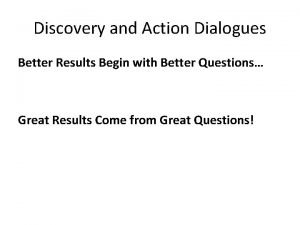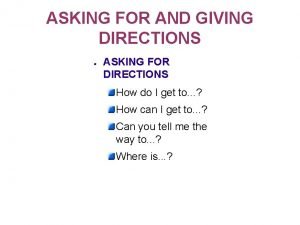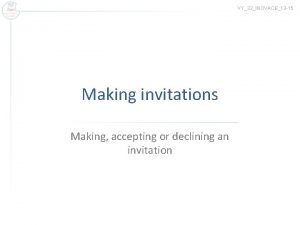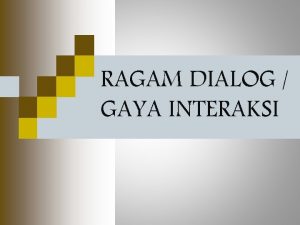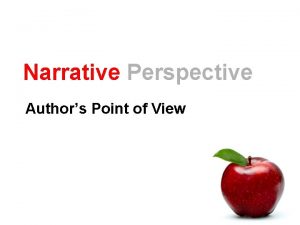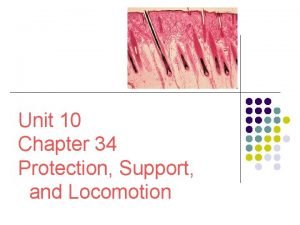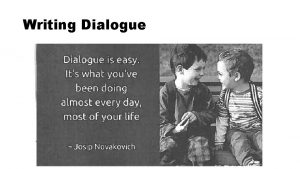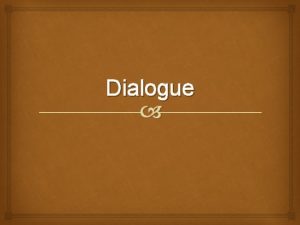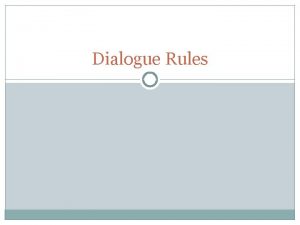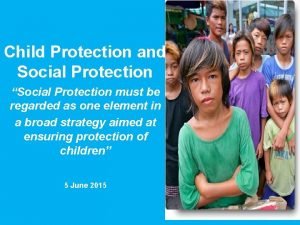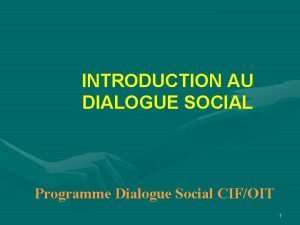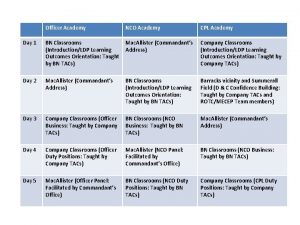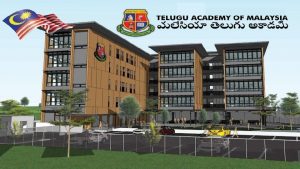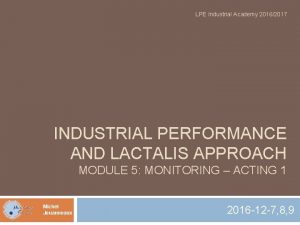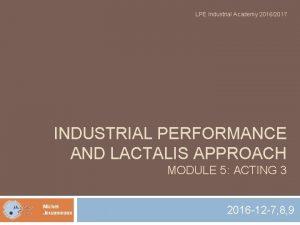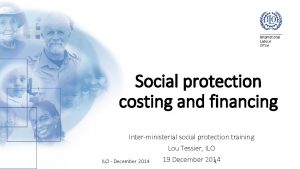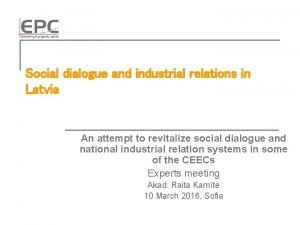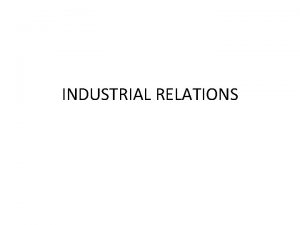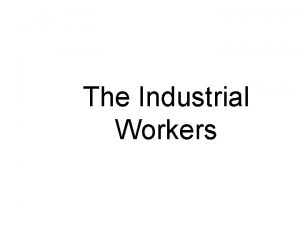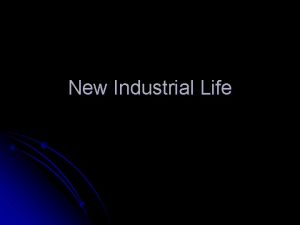Social protection Academy on social dialogue and industrial










































- Slides: 42

Social protection Academy on social dialogue and industrial relations Turin, 28 November – 9 December 2016

Structure of the course • Part I - Introduction on social protection (1 hour) • Part II - Social / national dialogue in social protection (1 hour)

Part I - Introduction on social protection • Part I - Introduction on social protection (1 hour) – – – Definition (including group exercises No. 1 and 2) Justification ILO standards Trends & situation The SPF concept and endorsement Wrap-up: social protection makes a difference in the life of people (including exercise No. 3)

Group exercise 1 (15’) • How would you define social protection in one sentence? • Instructions: – Discuss – Agree on a definition (one sentence) – Share the definition in plenary

What is social security/protection? • Poverty • Life cycle risks with financial consequences Maternity Sickness Families with children Unemployment Invalidity Work injury Death of the breadwinner Old age Medical care Lifecycle • Disasters and conflicts can intensify the need for social protection

What is social security/protection? • Access to social protection is a public responsibility which is typically provided through public institutions, financed from either social contributions or taxes or both • However the delivery of social protection can be and is often mandated to private entities

What is social security/protection?

Group exercise 2 (15’) • Identify one social protection scheme in your country and present it briefly to your neighbour • Instructions – Risks (health, old age, unemployment, maternity, family allowance, child benefits, work injury…) – Contributory or non contributory? – Population covered (civil servants, private sector employees, informal sector, poor households) – How is the scheme managed (tripartite board, or not) • One presentation per table

Why is social protection needed? A human right Social security and an adequate standard of living are human rights recognized in the Universal Declaration of Human Rights, 1948, Articles 22 and 25 http: //www. youthforhumanrights. org/ These rights are recognized in many countries constitutions

Why is social protection needed? An social and economic necessity Source: A. Mideros Mora, F. Gassmann, and P. Mohnen, 2012, Estimation of rates of return of social protection instruments in Cambodia: A case for non-contributory social transfers.

ILO’s standards to realize the right to social security/protection • ILO sets standards that lay down obligations and guidelines for ILO member States • Standards are of two types: Conventions and Recommendations • They help in drafting laws and regulations, designing and implementing social security systems

ILO’s standards to realize the right to social security/protection C 183 C 130 Maternity Sickness C 168 C 121 Unemployment Work injury C 130 Medical care Convention No. 102 covers all 9 contingencies Families with children Invalidity Death of the breadwinner Old age C 183 C 128 Lifecycle

Major social protection trends Rapid extension of legal coverage A Story of more than 100 Years: Building Social Security Systems https: //www. youtube. com/watch? feature=player_embedded&v=Amn_e. Qoyns. Q

However social protection is not yet a reality for too many 73% of the world population is not adequately covered. Globally, 39% of the population is lacking coverage in health. 50% of the world’s children live in poverty. 12% Only of unemployed workers worldwide actually receive unemployment benefits. 50% Nearly of all people over pensionable age do not receive a pension. http: //www. socialprotection. org/gimi/gess/ Show. Theme. action? th. th eme. Id=3985

The social protection floor concept • Over the life cycle all in need have – Access to essential health care – Access to basic income security – Effective access to goods and services defined as necessary at the national level • Rights-based • Life-cycle

The social protection floor concept • Social protection system, composed of schemes and programmes (diversity) • The floor is the minimum level guaranteed at the national level; it is not an additional scheme Level of protection Social protection floor Poor Rest of informal sector Population Formal sector

The social protection floor concept All residents have access to essential health care, including maternity care All children enjoy basic income security, providing access to nutrition, education, care, and any other necessary goods and services All persons in active age who cannot earn sufficient income, enjoy basic income security, particularly in cases of sickness, unemployment, maternity, disability All older persons have basic income security

SPF endorsed globally: Adoption of Recommendation 202, 2012 • ILO’s Recommendation on Social Protection Floors, 2012 (No. 202) was endorsed by 185 member States in June 2012 with 456 ‘yes’ votes and 1 ‘not present’ • Recommendation No. 202 guides member States on establishing and maintaining nationally defined SPFs • No one size fits all approach http: //www. ilo. org/wcmsp 5/groups/public/--ed_norm/--relconf/documents/meetingdocument/wcms_18332 6. pdf

SPF endorsed globally: The 2030 Development Agenda • Social protection including social protection floors is a priority of the 2030 Agenda Target 1. 3 Target 3. 8 - Achieve Implement nationally universal health appropriate social coverage … protection systems and measures for all, including floors, and by 2030 achieve substantial coverage of the poor and the vulnerable Target 5. 4 Recognize and value unpaid care and domestic work through the provision of public services, infrastructure and social protection policies … Target 8. 5 - By 2030, achieve full and productive employment and decent work for all women and men … Target 10. 4 - Adopt policies, especially fiscal, wage and social protection policies, and progressively achieve greater equality

SPF endorsed globally: 36 LIC and MIC countries are moving towards universal social protection Argentina Armenia Azerbaijan Belarus Bolivia Botswana Brazil Brunei Cabo Verde Chile China Cook Islands Georgia • • • Guyana India Kazakhstan Kiribati Kosovo Kyrgyz Republic Lesotho Maldives Mauritius Mongolia Namibia Nepal • • • Samoa Seychelles South Africa Swaziland Tanzania (Zanzibar) Thailand 900 Timor-Leste Trinidad Tobago 700 Ukraine 500 Uruguay 300 Uzbekistan Example: China Expansion of old-age pension coverage over 2001 -2013 Number of people covered (in millions) 100 20 01 20 02 20 03 20 04 20 05 20 06 20 07 20 08 20 09 20 10 20 11 20 12 20 13 • • • • Source: universal. social-protection. org All the country cases: http: //www. social-protection. org/gimi/gess/New. York. action? id=34

Why is social protection important to me? https: //www. youtube. com/watch? v=q 0 WU 8 kjzm. I&list=PLALOQNj. Qjy. MDGs. TS 8 q. Lftfwz. Hs 6 Lb. GApm&index=2

Exercise 3: Take two minutes to think about social protection and answer the question (15’) >> Why is social protection important to you?

Part II - Social / national dialogue in social protection (1 hour) • Part II – Social / national dialogue in social protection (1 hour) – Main steps to build SPFs – Social dialogue and social protection in ILO C 102 and R 202 (exercise No. 4) – Step 1: Assessment Based National Dialogue – Step 2: Tripartite design including legal drafting – Step 3: Participation in operations (including exercise No. 5) – All in one! Wrap – up with exercise No. 6

Main steps to build SPFs Defining the SPF and SP strategy Design & reforms of schemes � � Improvement of operations Monitoring of progress Assessment based national dialogue to identify gaps, provide recommendations and costing & impact calculations Feasibility studies on policy design, institutional, actuarial and legal studies Assessment of operations leading to recommend-dations (administrative & financial governance) Monitoring of progress leading to recommendations and steps ❶❷❸ Scenarios 1, 2, 3 … Tripartite/national endorsement National SPF defined & strategy adopted Scheme design and legislative framework adopted Pilot test / roll out of the recommendations; amendment of the law Recommendations leading to steps 1, 2 or 3 ❺ Development of a culture for social protection

Exercise 4: Social dialogue and social protection in ILO C 102 and R 202 • Read R 202 • http: //www. ilo. org/dyn/normlex/en/f? p=NORMLEXPUB: 12 100: 0: : NO: : P 12100_INSTRUMENT_ID: 3065524 • Read C 102 http: //www. ilo. org/dyn/normlex/en/f? p=NORMLEXPUB: 12 100: 0: : NO: : P 12100_INSTRUMENT_ID: 312247 • CTRL Find: «social dialogue» , «participation» , «consultative» , «tripartite» , «representative» , «employers» , «workers» , «persons concerned» , «complaint» and «appeal» • Identify the role of social partners and other representatives of persons concerned in each of the steps to build SPFs • And fill the following slide

Exercise 4: Social dialogue and social protection in ILO C 102 and R 202 � � Defining the SPF and SP strategy Design & reforms of schemes Improvement of operations Monitoring of progress Fill with article/ paragraph ❺ Development of a culture for social protection Fill with article/ paragraph

Exercise 4: Social dialogue and social protection in ILO C 102 and R 202 � � Defining the SPF and SP strategy National dialogues to formulate national SP strategies – Para. 13(1) of R 202 ❺ Design & reforms of schemes Establishment & review of the levels of benefits – Para. 3(r) and 8(d) of R 202 Improvement of operations Monitoring of progress Participatory management, consultations, enforcement – Tripartite participation & consultation with other representative organizations – Article 72, 70(1&3) and 6(a) of C 102; Para. 3(r) and 7 of R 202 Para. 19 of R 202 Development of a culture for social protection Raise awareness and undertake information programmes, including through social dialogue – Para. 14 (f) of R 202 Article 70(1), Convention No. 102

Step 1: Assessment Based National Dialogues Defining the SPF and SP strategy Assessment based national dialogue to identify gaps, provide recommendations and costing & impact calculations Scenarios 1, 2, 3 … Tripartite/national endorsement National SPF defined & strategy adopted • Objectives: define the SPF and social protection strategy • Methodology: consensus building process through a mix of bilateral and broad consultations, capacity building and technical studies • Outcome: national SPF and SP strategy endorsed at the Vice President or PM levels • Situation: ABNDs completed in 5 countries, ongoing in 11 countries

Phase 3 ABND in Thailand 9. Endorsement by UN/RTG joint team and presentation to the government (Oct-Nov 2012) 8. Finalization of Costing, Fiscal space, Writing ABND report (May-Aug 2012) Phase 1 1. Inventory of schemes (Jun 2011) 2. Draft Assessment Matrix (Jul 2011) 3. Dialogue # 1 on ABND matrix (Aug 2011) National Social Protection task team 7. Dialogue # 3 on results of costing (Mar 2012); Training on costing (May 2012) 6. Data collection for the RAP protocol and costing of the scenarios (Nov 2011 - Mar 2012) 4. Translation of policy recommendations into practical scenarios 5. Dialogue # 2 on proposed scenarios (Nov 2011, Feb 2012) Phase 2

Stakeholders involved Line ministries (Labour, Health, Social Welfare, Planning, Interior, Education, Finance, Rural Development, Women’s Affairs, etc. ), social security institutions Local governments National Statistics Office, academicians UN agencies involved in SPF (ILO, UNICEF, WHO, UNESCAP, UNFPA, UNAIDS, UNESCO, UNWOMEN, UNDP, WFP), World Bank, ADB, other development partners Workers’ and employers’ organizations Civil society

Step 2: Tripartite design including legal drafting Design & reforms of schemes Feasibility studies on policy design, institutional, actuarial and legal studies Scenarios 1, 2, 3 … Tripartite/national endorsement Scheme design and legislative framework adopted • Objectives: broad design of the policy, institutional design, actuarial and legal studies leading to recommendations on the creation/amendment of social security laws • Methodology: consensus building process through tripartite consultations, capacity building and studies • Outcome: design study endorsed by the tripartite social security board or committe; law passed in parliament • Situation: tripartite design and legal drafting is mainstreamed for social insurance; not many examples yet for social assistance

Design of Unemployment Insurance in Malaysia 7. Presentation of the study at a tripartite forum and submission to the TPC 1. Establishment of the TPC (March 2012) 6. Feasilibility study (actuarial and legal assessments, institutional) (August 2012 -xx 2013) National Tripartite Project Committee Phase 2: Feasibility study Phase 1: facilitate a consensus on UI in Malaysia 2. International comparison and benchmarking study on unemployment protection in 14 countries 3. Desk review of the labour market and economic indicators & measures to protect the unemployed in Malaysia (March-May 2012) 4. Fact finding mission and tripartite national & regional workshops to build capacity + share information + collect opinions including through a survey (May 2012) 5. TPC endorsement of the broad design (pillar 1: UI ; pillar 2: ALMPs ; pillar 3: savings) (June 2012)

Design of Unemployment Insurance in Malaysia (survey results) • Shall a UI be established in Malaysia? Government Employer Employee Other TOTAL Yes 31 16 43 76 166 No TOTAL 0 31 20 36 2 45 5 81 27 193 • Who should contribute? Contributions Government Employer Employee Others TOTAL Tripartite Bipartite Other TOTAL 16 16 1 31 18 9 3 36 32 10 3 45 60 25 3 80 126 60 10 193

Design of Unemployment Insurance in Malaysia (survey results) • Types of protection TOTAL Income Replacement linked to previous earnings 91 (47. 2%) Measures supporting return to work – vocational training etc 79 (40. 9%) Flat Rate Income Replacement 54 (28. 0%) Measure supporting creation of business 41 (21. 1%) Preventive Measures – to maintain empl. in enterprises 36 (18. 7%) Replace severance pay with unemployment insurance 33 (17. 1%) Lump Sum under individual savings accounts 30 (15. 5%) Maintain severance pay (and add UI) at present level 21 (10. 9%) Maintain severance pay (and add UI) at lower level 15 (7. 8%)

Stakeholders involved Indirectly represented Malaysia Employers’ Federation (MEF) Social Security Organization (SOCSO) Malaysia Trade Union Congress (MTUC) Ministry of Hurman Resources (Mo. HR) Other employers and workers organizations Civil society, NGOs, academia, consumer groups, politicians, the Federal Treasury, etc.

Development of a Social Protection Law in OPT Phase 3: adoption 12. Adoption of Amended Social Security Law following further consultation with ILO and civil society (Sept. 2016) 1. Adoption of Presidential Decree to enact the law (March 2016) 10. Endorsement by Council of Ministers (Feb. 2016) 1. Broad design of the policy framework by tripartite stakeholders (2013) Phase 1: preparation 2. Establishment of the TNSSC and the ad hoc Social Security Task Force (2013) Tripartite National SS Committee 3. Adoption of the policy framework by the TNSSC (Dec. 2013) 4. Actuarial valuation of the policy framework (2013) 9. Adoption of draft law by Phase 2: 5. Establishment of Legal the TNSSC (Oct. 2015) studies Drafting Committee (2014) 8. Study on administration 6. Drafting new Social (2015) Security Law (2014 -2015) 7. Capacity building & study tours (2014 - 2015)

Step 3: Participation in operations � Improvement of operations Assessment of operations leading to recommend-dations (administrative & financial governance) Scenarios 1, 2, 3 … Tripartite/national endorsement Pilot test / roll out of the recommendations; amendment of the law • Objectives: Identify and enrol all eligible insured and beneficiaries; guarantee regular and reliable delivery of services or transfers; be accountable for use of resources and performance • Methodology: Tripartite social security boards, consultative committees, awareness raising, involvement of civil society for watch dog function • Outcome: better access, better awareness of rights and responsibilities, feedback to improve policy and operations • Situation: participation in operations is mainstreamed for social insurance; it is emerging for non-contributory schemes

Administrative functions Registration Contributions Social protection front office MSU* Communication Judicial body Higher level administrative authority Local SS body Feedback Services Transfers * «Management Support Unit» : Management Information System, Monitoring, Service quality, Management of HR, Financial management Complaints & appeals

Social security councils • Supervision of implementation • Recommendations to improve policy and operations • Choice of investment policy • Representation (W, E, beneficiaries) Registration Contributions Judicial body Tripartite SP Board Social protection front office MSU* Communication CSOs, associations • • Awareness raising on the SP scheme Facilitation of enrolments Chanel the voice of beneficiaries Act as watchdogs Feedback Services Transfers Consultative committees Higher level administrative authority Local SS body Tripartite dispute settlement mech. Complaints & appeals • Solutions to complaints and appeals • Recommendations to improve policy and operations based on people’s needs

Exercise 5: link the boxes! In Kenya, the NSSF Board is composed of a chairperson (appointed by Cabinet), 2 principal secretaries (on finance and social security), 2 employers rep. , 2 workers rep. , 3 SS experts, the managing trustee. In Cambodia, the Children and Women Consultative Committee was intended to take an active role in the social protection delivery mechanism. In Thailand, national and international NGOs have played a key role in pushing forward the reform that has led to the installation of the universal health care scheme. Social security councils Social Protection Tripartite Boards & dispute settlement mechanisms In Algeria, a special tripartite committee composed of representatives of workers, employers, and credit unions, are empowered to rule on disputes arising between SS institutions and the insured. Consultative commitees In Brazil, national and local Social Security Councils capture the views and specific needs of local populations. Both national and local Social Security Councils are quadripartite and include representatives of government, employers, workers and retirees. Civil society organizations

Exercise 6: All in one • Instructions: – Split in four groups – Group 1: ABND, group 2: legal framework, group 3: administration, group 4: culture – Explain how social/national dialogue was put in practice • Examples: – ABND: http: //www. socialprotection. org/gimi/gess/Beijing. action? id=35 – Developing the Legal framework: http: //www. socialprotection. org/gimi/gess/Beijing. action? id=36 – Administration: http: //www. socialprotection. org/gimi/gess/Beijing. action? id=38 – Culture: http: //www. socialprotection. org/gimi/gess/Beijing. action? id=39

 Conversation conversation
Conversation conversation Dialogue between social worker and client example
Dialogue between social worker and client example Handle information in care settings
Handle information in care settings Cleveland arts & social sciences academy
Cleveland arts & social sciences academy Social protection operational framework philippines
Social protection operational framework philippines Social protection instruments
Social protection instruments Social protection operational framework philippines
Social protection operational framework philippines Social protection
Social protection Ilo social protection
Ilo social protection Industrial revolution and social darwinism
Industrial revolution and social darwinism Social innovation academy
Social innovation academy Social thinking and social influence
Social thinking and social influence Social thinking social influence social relations
Social thinking social influence social relations Industrial achievement model of social welfare
Industrial achievement model of social welfare Narration and dialogue
Narration and dialogue Dialogue receptionist and guest
Dialogue receptionist and guest Practise this dialogue with your friend
Practise this dialogue with your friend Taking leave and response
Taking leave and response Interface and dialogue design
Interface and dialogue design Intensive and extensive speaking
Intensive and extensive speaking Tell past events
Tell past events It is used when asking and giving permission
It is used when asking and giving permission Strategic prospecting
Strategic prospecting What is the difference between dialect and dialogue
What is the difference between dialect and dialogue Snap crackle pop pick up line
Snap crackle pop pick up line Expressing likes and dislikes dialogues
Expressing likes and dislikes dialogues Discovery and action dialogue
Discovery and action dialogue At the clothes shop dialogue
At the clothes shop dialogue Asking and giving directions dialogue
Asking and giving directions dialogue Making accepting and declining invitations
Making accepting and declining invitations Read the dialogue
Read the dialogue How to use punctuation in quotes
How to use punctuation in quotes Simple and natural dialogue
Simple and natural dialogue Dialogue design in system analysis and design
Dialogue design in system analysis and design Simple and natural dialogue
Simple and natural dialogue Dialogue between cat and mouse
Dialogue between cat and mouse Ciri khas interface question & answer dialogue adalah
Ciri khas interface question & answer dialogue adalah Dialogue narration
Dialogue narration Listen and complete the dialogue
Listen and complete the dialogue Look at the model dialogue and change the words in blue
Look at the model dialogue and change the words in blue Conversation between teacher and student
Conversation between teacher and student Chapter 34 protection support and locomotion
Chapter 34 protection support and locomotion Safeguarding and child protection the essentials
Safeguarding and child protection the essentials

